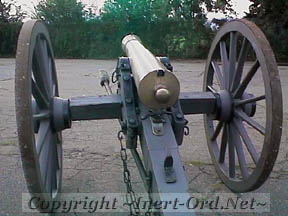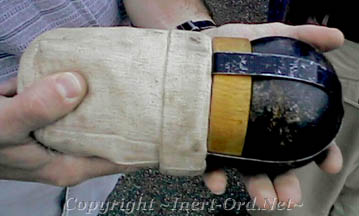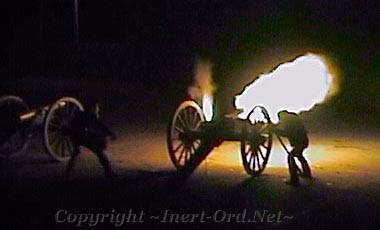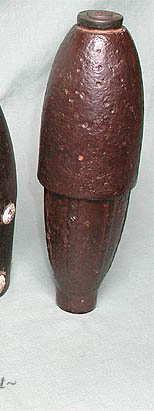
Bronze "6 Pounder" - Smooth Bore Field Gun

6 Pound Solid Shot with "Fixed" Propellant Bag
Up to about 1850, the smooth bore field cannon was "Queen of the Battlefield". Artillery could reach out effectively to well over 800 yards. At close range (~250 yards) "Canister" shot was used. Canister (a thin-walled container, containing large amounts of bullet-size lead balls) transformed cannon into giant shotguns.
Infantry, armed with the smooth bore musket, could only bring effective fire to bear at under 100 yards. Advancing troops could do nothing but endure the hail of destruction. Field artillery dominated the ground. It had a long reach and infantry suffered for it.
The advent the rifled musket, with improved range and accuracy, put the smooth bore cannon at a disadvantage. Infantry now had the capability to attack opposing gun positions from a much greater distance. Before, artillery was often brought into position in full view of the enemy at 500 yards. Now the exposed nature of manned artillery pieces made them vulnerable. For the first time, massed volleys of long range rifle fire could do more damage to artillery crews than they in return. The dominant role of artillery on the battlefield was threatened.
 The rifled musket used a conical bullet made of soft lead with a hollow base, known as the Minié Ball.
Smaller than the gun's bore diameter it was easily loaded from the muzzle.
When fired, the hollow base allowed the bullet skirt to be forced outward
making a tight fit which resulted in higher muzzle velocity. Rifling (helical
grooves in the barrel wall) spun the bullet providing better accuracy. The
bullet's conical shape made for a more massive projectile than a round ball
of the same caliber. This development vastly improved the performance of
the smooth bore musket. Cannon would benefit by this same technology as well,
but that proved to be a much more difficult design challenge.
The rifled musket used a conical bullet made of soft lead with a hollow base, known as the Minié Ball.
Smaller than the gun's bore diameter it was easily loaded from the muzzle.
When fired, the hollow base allowed the bullet skirt to be forced outward
making a tight fit which resulted in higher muzzle velocity. Rifling (helical
grooves in the barrel wall) spun the bullet providing better accuracy. The
bullet's conical shape made for a more massive projectile than a round ball
of the same caliber. This development vastly improved the performance of
the smooth bore musket. Cannon would benefit by this same technology as well,
but that proved to be a much more difficult design challenge.A vast field, late 19th century artillery is a fascinating subject of study. Further explore details of a few items below.
A visit to this website, civilwarartillery is also time well spent.




